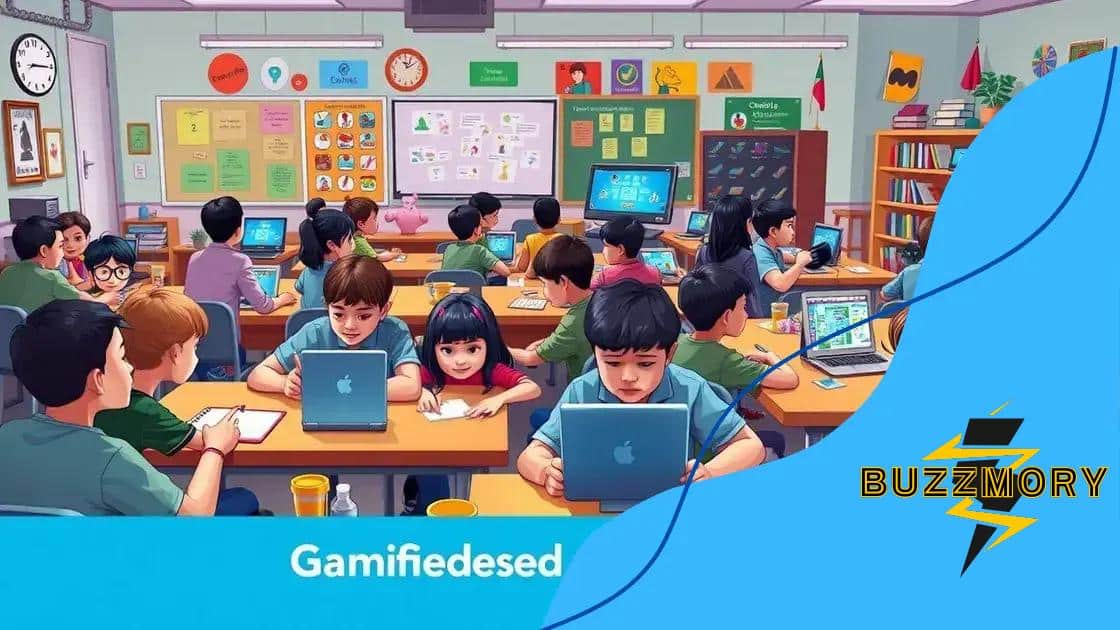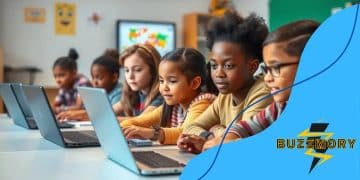How gamification is increasing engagement in the classroom

Gamification is the integration of game elements into the classroom, enhancing student engagement and motivation through points, badges, and interactive activities, while also utilizing technology like virtual reality for effective learning experiences.
How gamification is increasing engagement in the classroom has become a hot topic among educators. It offers a fun approach to learning that captivates students’ attention. Ever wondered how games can make lessons more exciting and effective?
Understanding gamification in education
Understanding gamification in education is essential for creating an engaging learning environment. Teachers are finding ways to incorporate game-like elements into their lessons to motivate students and enhance their learning experiences. But what exactly does this mean?
Gamification involves using game mechanics in non-game contexts. In education, this can mean adding points, badges, or leaderboards to learning activities. These features can transform a standard classroom into a more dynamic and interactive environment.
Key Elements of Gamification
Several key elements contribute to effective gamification:
- Points System: Points reward students for completing tasks, encouraging participation.
- Badges: Visual rewards for achieving milestones can motivate students to strive for excellence.
- Leaderboards: Showcasing top performers fosters healthy competition among peers.
- Challenges: Engaging activities that promote critical thinking and creativity.
These components work together to create a fun atmosphere that encourages learning. Consider how students react when they earn points for participation or receive badges for completing projects. This positive reinforcement can lead to increased enthusiasm for learning.
Moreover, gamification promotes collaboration. Students often work together to achieve goals, enhancing their social skills and teamwork. This experience is different from traditional learning methods, where competition may overshadow collaboration.
The beauty of gamification lies in its flexibility. Teachers can tailor game mechanics to fit their curriculum and the specific needs of their students. Whether it’s adapting a science project into a competitive challenge or using digital tools to track progress, the possibilities are endless.
Incorporating game elements requires creativity and planning. Educators should reflect on what engages their students the most. Are they more inclined to participate in challenges, or do they thrive on a sense of achievement? Adjusting strategies according to the students’ preferences can maximize the benefits of gamification.
Overall, understanding gamification in education helps teachers create shared experiences where learning becomes an exciting adventure. As education evolves, gamification is likely to play a vital role in keeping classrooms engaging and relevant, ensuring students remain inspired.
Benefits of gamification for student engagement
Exploring the benefits of gamification for student engagement reveals how game-like elements can transform traditional learning environments. By adding excitement to lessons, educators can capture students’ attention and enhance their motivation. Students are more likely to participate actively when their learning resembles play.
One of the most significant advantages of gamification is increased motivation. When students earn points and badges for their accomplishments, they feel recognized for their efforts. This recognition reinforces positive behavior and can lead to improved performance.
Key Benefits of Gamification
Several key benefits influence how gamification can engage students:
- Enhanced Retention: Gamified lessons help students remember information longer due to repetitive and interactive experiences.
- Improved Collaboration: Working together on challenges encourages teamwork and improves communication skills.
- Instant Feedback: Gamification often provides immediate feedback, allowing students to understand their strengths and areas for improvement quickly.
- Increased Participation: Fun elements draw in even the most reluctant learners, making them eager to take part in activities.
Additionally, gamification supports diverse learning styles. Visual learners may thrive in environments with colorful graphics and visual rewards, while kinesthetic learners enjoy hands-on challenges. This adaptability helps ensure that all students can find success.
Moreover, the competitive aspect of gamification can motivate students to strive for academic excellence. Leaderboards inspire healthy competition, offering students the opportunity to see how they compare with their peers. Such competition can lead to a more energetic classroom atmosphere, where every student feels motivated to excel.
In terms of long-term engagement, gamification can also foster a lifelong love of learning. When students associate education with fun and achievement, they are more likely to continue seeking knowledge outside of the classroom. This mindset prepares them for future successes.
Practical examples of gamification in the classroom

Practical examples of gamification in the classroom can provide valuable insights into how educators can effectively engage their students. Implementing game elements into lessons brings a fresh approach to learning and enhances the overall educational experience.
One popular example is using points systems similar to video games. Teachers can award points for participation, completing assignments, and achieving learning goals. This not only motivates students but also makes learning more interactive.
Game-Based Learning Activities
Another effective method is incorporating game-based learning activities. These activities can range from educational board games to digital platforms that allow students to progress through levels. Consider these approaches:
- Role-Playing Games: Students take on characters and work together to solve problems, enhancing teamwork and critical thinking.
- Simulation Games: Simulations can mimic real-world scenarios in subjects like science and history, making lessons feel more relevant.
- Interactive Quizzes: These can be set up as competitions among classmates, promoting healthy rivalry and reinforcing knowledge.
Furthermore, badges serve as a great way to recognize student achievements. For instance, students can earn badges for completing units or mastering specific skills. This visual representation of accomplishments boosts confidence and drives them to pursue further success.
Additionally, utilizing digital platforms that support gamification can enhance classroom dynamics. Tools like Kahoot! or Classcraft allow teachers to create engaging quizzes and competitions that energize learning. With immediate feedback and rewards, students are more likely to stay engaged.
Moreover, educators can set challenges that encourage creativity and problem-solving. For example, projects that require students to design a game or create a story can lead to innovative thinking. Integrating technology can further enrich these experiences.
By incorporating these **practical examples of gamification in the classroom**, teachers can transform traditional lessons into dynamic, engaging experiences. This shift not only captures student interest but also creates a positive learning environment that fosters collaboration and enthusiasm.
Challenges educators face with gamification
Challenges educators face with gamification can impact the effectiveness of implementing game elements in the classroom. While the benefits are clear, navigating these obstacles is crucial for success. Recognizing these challenges allows teachers to find solutions that enhance student engagement.
One significant issue is resistance from students who may not respond positively to gamified approaches. Some students might see gamification as childish or irrelevant, causing a disconnect with classroom activities. This can hinder their willingness to participate actively.
Common Challenges in Implementing Gamification
Here are several challenges educators frequently encounter with gamification:
- Resource Constraints: Not all schools have access to technology or materials needed for effective gamification. Limited resources can prevent the creation of engaging activities.
- Time Management: Designing gamified lessons takes time and effort. Teachers are often pressed for time, making it challenging to integrate new strategies.
- Student Diversity: Not all students learn the same way. Some may thrive under gamified systems, while others may struggle, leading to disparities in engagement.
- Assessment Issues: Traditional methods of assessment may not align with gamified strategies. Educators must find ways to evaluate student performance that reflect the benefits of a gamified approach.
Furthermore, many educators may lack training on gamification. Without adequate understanding, teachers might implement elements incorrectly, leading to confusion and disengagement among students. Professional development can help address this gap, guiding teachers on best practices.
Additionally, some students may focus too much on competition rather than learning. While healthy competition can motivate students, it can also lead to stress or anxiety for those who struggle to keep up. Teachers should balance competitive elements with collaborative activities to foster a supportive environment.
Lastly, ensuring that gamification aligns with educational goals is vital. Teachers need to ensure that game mechanics enrich the learning experience, adding educational value rather than detracting from core objectives.
Future trends in classroom gamification
Future trends in classroom gamification promise to reshape the learning experience as technology and educational methods evolve. Educators are adapting to new tools and techniques to keep students engaged. Understanding these trends can help teachers prepare for the future.
One emerging trend is the integration of **virtual reality (VR)** and **augmented reality (AR)** in gamified lessons. These technologies immerse students in interactive environments, allowing them to explore and learn in lifelike scenarios. Imagine a biology class where students can virtually dissect a frog or a history lesson that transports them to ancient Rome.
Key Trends Shaping Classroom Gamification
Here are some key trends to watch:
- Personalized Learning: Gamification is becoming more tailored to individual learning styles. Adaptive learning platforms will provide customized experiences, allowing students to work at their own pace and level.
- Microlearning: Short, focused learning modules that students can complete quickly are gaining popularity. This approach fits into busy schedules and helps maintain attention by breaking up content into manageable segments.
- Data-Driven Insights: Teachers will increasingly use data analytics to track student progress and engagement levels. This information can help educators adjust their gamification strategies for better outcomes.
- Collaborative Learning: Group-based games and activities that promote teamwork will become more common. Collaboration encourages communication skills and fosters a sense of community among students.
Additionally, the rise of **gamification platforms** will make it easier for educators to design and implement gamified curriculum. These platforms often include ready-made content, tools for creating custom games, and analytics to measure success.
Another significant trend is the use of **social media and online communities** for gamification. Students can engage in challenges, share achievements, and participate in competitions with peers around the globe. This connectivity enhances learning and creates a sense of belonging.
These future trends in classroom gamification indicate a shift towards more dynamic and interactive learning environments. By embracing these developments, educators can create more engaging experiences that ultimately lead to better student outcomes.
FAQ – Frequently Asked Questions about Gamification in the Classroom
What is gamification in education?
Gamification in education refers to incorporating game elements like points, badges, and challenges into learning activities to enhance student engagement.
How can gamification increase student motivation?
By rewarding students for their achievements and making learning fun, gamification encourages them to participate actively in classroom activities.
What are some examples of gamification in the classroom?
Examples include using points systems, incorporating educational games, and providing badges for completing lessons or mastering skills.
What challenges do educators face with gamification?
Challenges include resistance from some students, lack of resources and training, and balancing competition with collaboration among learners.





